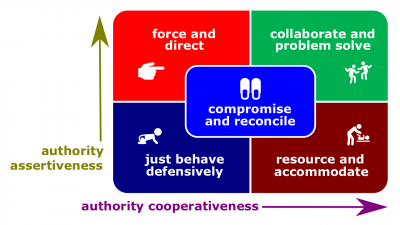Conflict-resolution strategy
Revision as of 01:59, 21 November 2018 by Gary (talk | contribs) (Created page with "400px|thumb|right|[[Conflict-resolution strategy]]Conflict-resolution strategy (hereinafter, the ''Strategy'') is a policy behind a ...")
Conflict-resolution strategy (hereinafter, the Strategy) is a policy behind a conflict-resolution technique to be chosen in order to resolve the conflict.
Types
- Just behave defensively. The conflict-resolution strategy behind conflict-suppressing techniques that involve retreating from an actual or potential conflict situation; postponing active involvement to be better prepared or to wait the conflict to be resolved by others and/or to fade with time.
- Resource and accommodate. The conflict-resolution strategy behind conflict-solving techniques that involve (a) adding resources to solve the conflict and/or (b) conceding one's position to the needs of others to maintain harmony and relationships.
- Compromise and reconcile. The conflict-resolution strategy behind conflict-solving techniques that involve searching for solutions that bring some degree of satisfaction to all parties in order to temporarily or partially resolve the conflict.
- Force and direct. The conflict-resolution strategy behind conflict-suppressing techniques that involve pushing one's viewpoint at the expense of others; offering only win-lose solutions, usually enforced through a power position to resolve an emergency.
- Collaborate and problem solve. The conflict-resolution strategy behind conflict-solving techniques that involve incorporating multiple viewpoints and insights from differing perspectives; requires a cooperative attitude and open dialogue that typically leads to consensus and commitment.
